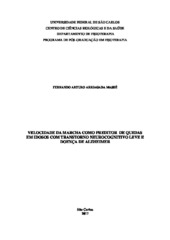| dc.contributor.author | Arriagada Massé, Fernando Arturo | |
| dc.date.accessioned | 2017-06-13T18:12:18Z | |
| dc.date.available | 2017-06-13T18:12:18Z | |
| dc.date.issued | 2017-02-23 | |
| dc.identifier.citation | ARRIAGADA MASSÉ, Fernando Arturo. Velocidade da marcha como preditora de quedas em idosos com transtorno neurocognitivo leve e doença de Alzheimer. 2017. Dissertação (Mestrado em Fisioterapia) – Universidade Federal de São Carlos, São Carlos, 2017. Disponível em: https://repositorio.ufscar.br/handle/ufscar/8856. | * |
| dc.identifier.uri | https://repositorio.ufscar.br/handle/ufscar/8856 | |
| dc.description.abstract | Background: Little is known about how the change in walking speed in longitudinal studies can predict the occurrence of falls in older adults with mild cognitive impairment. Objetives: To identify if there are differences in the gait speed of Cognitively Preserved (CPr) elderly persons, elderly persons with Mild Cognitive Impairment (MCI) and with Alzheimer`s Disease (AD) in mild stage, in a 6-month period. To verify if the change in the gait speed (ΔGS= Final Gait speed – Initial Gait speed) predicts the occurrence of falls in elderly with MCI and AD in mild stage. Methods: 110 elderly people participated in the study. Out of these: 40 with CPr, 36 with MCI and 34 with AD in the mild stage. Initially the 10-meter walk test was applied and a fall schedule was given. A 6-month follow-up was carried out, by means of monthly telephone calls to the volunteers and the filling of a fall schedule. After six months, the 10-meter walk test was applied and the fall schedule was retrieved. Results: The MCI and AD groups of elderly in mild stage presented lower gait speed compared to the elderly in the CPr group at the two assessment moments. There was no significant difference in delta gait speed amongst the groups. In the age-adjusted univariate logistic regression analysis, the delta failed to predict falls in the elderly with MCI or in elderly with AD. Conclusion: Older adults with MCI and AD in the mild stage were identified as having lower gait speed compared to CPr sujeitos. Changing in the gait speed over a six-month period does not predict the occurrence of falls in elderly with MCI or AD in mild stage. | eng |
| dc.description.sponsorship | Outra | por |
| dc.language.iso | por | por |
| dc.publisher | Universidade Federal de São Carlos | por |
| dc.rights.uri | Acesso aberto | por |
| dc.subject | Velocidade da marcha | por |
| dc.subject | Doença de Alzheimer | por |
| dc.subject | Comprometimento cognitivo leve | por |
| dc.subject | Quedas | por |
| dc.subject | Gait speed | eng |
| dc.subject | Alzheimer disease | eng |
| dc.subject | Mild cognitive impairment | eng |
| dc.subject | Falls | eng |
| dc.title | Velocidade da marcha como preditora de quedas em idosos com transtorno neurocognitivo leve e doença de Alzheimer | por |
| dc.type | Dissertação | por |
| dc.contributor.advisor1 | Souza, Larissa Pires de Andrade | |
| dc.contributor.advisor1Lattes | http://lattes.cnpq.br/7334391500340646 | por |
| dc.contributor.advisor-co1 | Takahashi, Anielle Cristhine de Medeiros | |
| dc.contributor.advisor-co1Lattes | http://lattes.cnpq.br/8336705133403404 | por |
| dc.description.resumo | Contextualização: Pouco se tem conhecimento sobre como a mudança da velocidade da marcha em estudos longitudinais, pode predizer a ocorrência de quedas em idosos com comprometimento cognitivo em estágios iniciais. Objetivos: a) identificar se há diferenças na velocidade da marcha entre idosos preservados cognitivamente (PrC) com transtorno neurocognitivo leve (TNL) e com doença de Alzheimer (DA) na fase leve ao longo de seis meses; b) Verificar se a mudança da velocidade da marcha (ΔVM= velocidade final - velocidade inicial) prediz a ocorrências de quedas em idosos com TNL e DA nesse período. Método: Participaram do estudo 110 idosos. Destes 40 PrC, 36 com TNL e 34 com DA. Inicialmente foi aplicado o teste de caminhada de 10 metros e entregue um calendário de quedas. Realizou-se um seguimento de seis meses por meio de ligações mensais para os voluntários e preenchimento do calendário de quedas. Após seis meses, aplicou-se novamente o teste de caminhada e o calendário de quedas foi resgatado. Resultados: Os idosos dos grupos com TNL e com DA apresentaram velocidades de marcha menor quando comparados com os idosos do grupo PrC, nos dois momentos de avaliação (p<0,001). Não houve diferença significativa no delta da velocidade da marcha entre os grupos (p=0,063). Na análise de regressão logística univariada, ajustado para idade, o ΔVM não conseguiu predizer quedas em idosos com TNL (p=0,185) nem em idosos com DA (p=0,232). Conclusão: Identificou-se que os idosos com TNL e DA na fase leve tem velocidades da marcha menores quando comparados com idosos PrC. A mudança da velocidade da marcha em um período de seis meses não prediz a ocorrência de quedas em idosos com TNL, nem idosos com DA na fase leve. | por |
| dc.publisher.initials | UFSCar | por |
| dc.publisher.program | Programa de Pós-Graduação em Fisioterapia - PPGFt | por |
| dc.subject.cnpq | CIENCIAS DA SAUDE::FISIOTERAPIA E TERAPIA OCUPACIONAL | por |
| dc.ufscar.embargo | Online | por |
| dc.publisher.address | Câmpus São Carlos | por |
| dc.contributor.authorlattes | http://lattes.cnpq.br/3227535730526385 | por |
